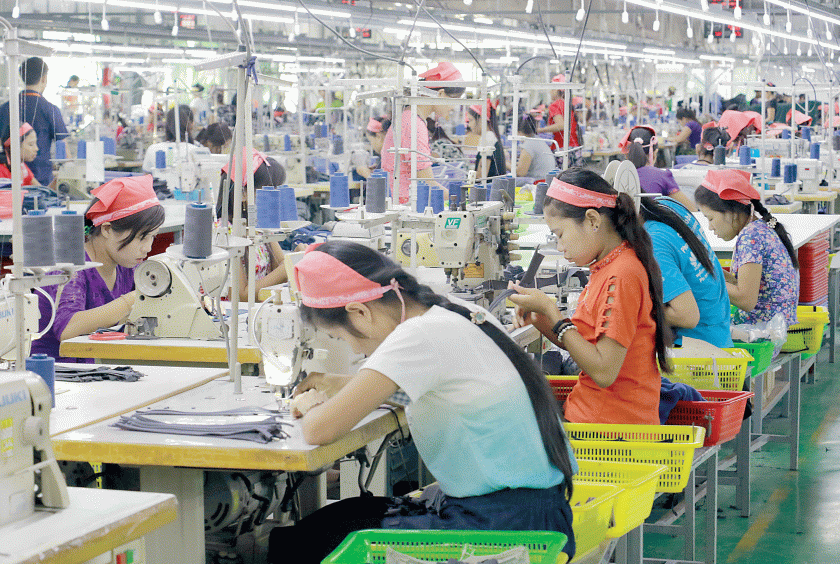What do you think of when discussing Garment Manufacturing? Does an image like the one above spring to mind?
When one thinks of garment manufacturing, one imagines workers huddled over production lines in factories come to mind. Each worker would be doing individual tasks such sewing or cutting, before handing off the garment to the next worker along the line. However, did you know that it is possible to automate the garment manufacturing process?
In this article, we present you with three examples showing how automation technology is reshaping garment manufacturing.
1: LOWRY Sewbots by SoftWear Automation

(Source: SoftWear Automation)
LOWRY Sewbots are invented by SoftWear Automation, an Atlanta-based company in the United States. Using advanced Fourth Industrial Revolution technologies such as computer vision and advanced robotics, these SewBots can analyse and manipulate fabrics just like a human. LOWRY Sewbots can perform multiple garment manufacturing tasks, such as cutting, seaming and sewing, labeling and quality inspection all through a single control touch panel. In addition, six LOWRY Sewbots can be controlled by a single machine operator, leading to increased productivity.
The SewBots’ multifunctional capabilities reduce the need for garment makers by 50-70%, according to this article. In the United States, where the Sewbot is made, the cost of making a denim shirt is $7.47. However, with a robotic production line, the cost per shirt falls to just $0.33. This enhances the United States’ productive competitiveness in relation to other countries.
Not only does this translate to lower costs for garment manufacturers, but the robots will also increase production. In eight hours, human sewing lines produce an average of 669 t-shirts. However, a robotic sewing line has the capacity to produce 1,142 t-shirts, which is a 71% increase in production. Therefore, by automating the sewing process, the garment manufacturing factory experiences an increase in production efficiency.
2: MAICA Italia Machines

Maica 3006, one of the many MAICA products for sale. The 3006 has been designed to manipulate garment collars.
(Source: MAICA Italia)
While the LOWRY SewBot is an innovative all-in-one machine, there are other automated machines that help to enhance the efficiency of different stages across the garment manufacturing process.
MAICA Italia is an Italian company that prides itself on their multiple lines of automated machines for shirts. Their range of products include automated sewing systems for different parts of a garment, including collars, cuffs and pockets. Each of their machines automate different stages of a garment worker’s workflow, such as pressing or fusing of garment components.
By automating different stages of the production line instead of the entire production process, a human-machine integration can be achieved, leading to higher efficiency and fewer job losses. Also, craftsmanship and quality control can be verified by expert human workers instead of machines, enabling manufacturers’ high quality standards to be consistently met.
3: Waist Band Marking Machine by Vector Consultancy
Granted, robotic automation machines may often come with a high price tag. However, the process of automating garment manufacturing need not always incur sky-high prices.
Vector Consultancy in India has developed a Waist Band Marking Machine, a low-cost automation machine that helps garment factory workers to mark multiple positions along a trouser waistband in one stroke.
A video demonstrating this is shown here:
While seemingly simple, a machine as low-cost as this delivers a reduction of up to 80% in manpower costs, and can mark up to 4,500 waist bands per worker shift. In addition, this machine is highly versatile. It can be used on bottoms made of any type of fabric, and can be installed in a centralised or individual-line setup in a factory.
To sum up, there are various levels to which garment manufacturers can automate their production processes in order to enhance their factories’ productivity. Once again, we witness the role of technology in fashion, and how innovative and interesting solutions are frequently being developed to modernise the industry.
5 Looks for the New Year’s Celebrations and Christmas 2022
Festive seasons are around the corner and getting ready in terms of fashion sense is vital. This article provides five inspirational looks for the new year’s celebration and Christmas 2022
10 Trends That Define the Spring 2022 Season
The fashion sector is mainly dependent on trends. Different trends usually come about during each season. We’ll now look into the 2022 fashion trends that are currently defining the Spring
Digitization in Fashion: Fashion In 3D
Every year, designers are pushing the boundaries of creativity by creating new materials and methods for 3D printing. 3D printing and scanning are being used to create entire collections, accessories,
Fashion Jobs That Are in Demand Now
The fashion industry is a fun, exciting and generally fast-paced work environment that many people find intriguing. While the pandemic has caused many people to lose their jobs in many

About the Author
Thaddeus Asher Han
Fashion Commentator & Creator
Fashion Journalist at Fashive
https://medium.com/@thaddeusasherhan
Some of Our Courses to Check Out
-
Advanced Certification in Apparel Merchandising
$1,500.00Original price was: $1,500.00.$750.00Current price is: $750.00.


